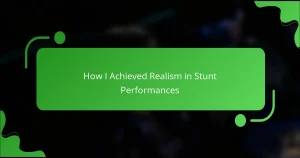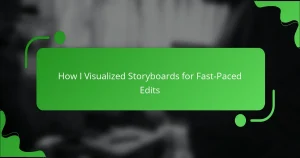Key takeaways
- Action short films rely on concise storytelling and emotional stakes to engage viewers effectively.
- Key elements of successful fight sequences include choreography, pacing, character motivation, and the use of space.
- Inspiration from classic films enhances fight choreography, focusing on emotional-driven movement and dynamic camera work.
- Collaboration and thorough planning are essential for developing impactful fight sequences and effective filming techniques.
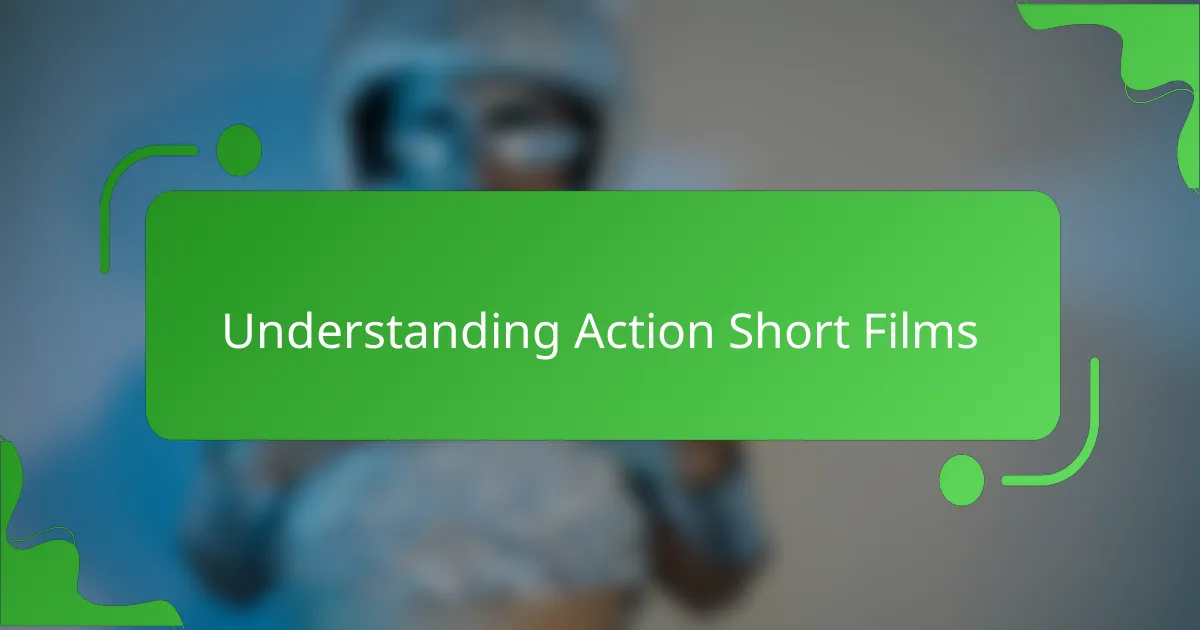
Understanding Action Short Films
Action short films hold a special place in the cinematic world. They encapsulate high-energy moments and intense storytelling within a limited timeframe, compelling filmmakers to be both creative and concise. I remember the first time I watched a gripping action short; the way every frame was packed with tension and narrative left a lasting impression on me.
Creating effective fight sequences, much like those seen in “Kill Bill,” demands not only choreography but also a deep understanding of character motivations and emotional stakes. Whether it’s the thrill of the chase or the desperation of a showdown, the emotion needs to resonate with the audience. Reflecting on my experiences, I found that embedding personal stakes into the choreography elevated the scenes from mere action to art.
- Action short films require concise storytelling that connects with viewers quickly.
- Effective fight sequences balance choreography with character development.
- Emotional stakes are vital for audience engagement and investment.
- Influential films like “Kill Bill” serve as inspiration for crafting impactful moments.
- Watching diverse fight styles can spark creative ideas for choreography.
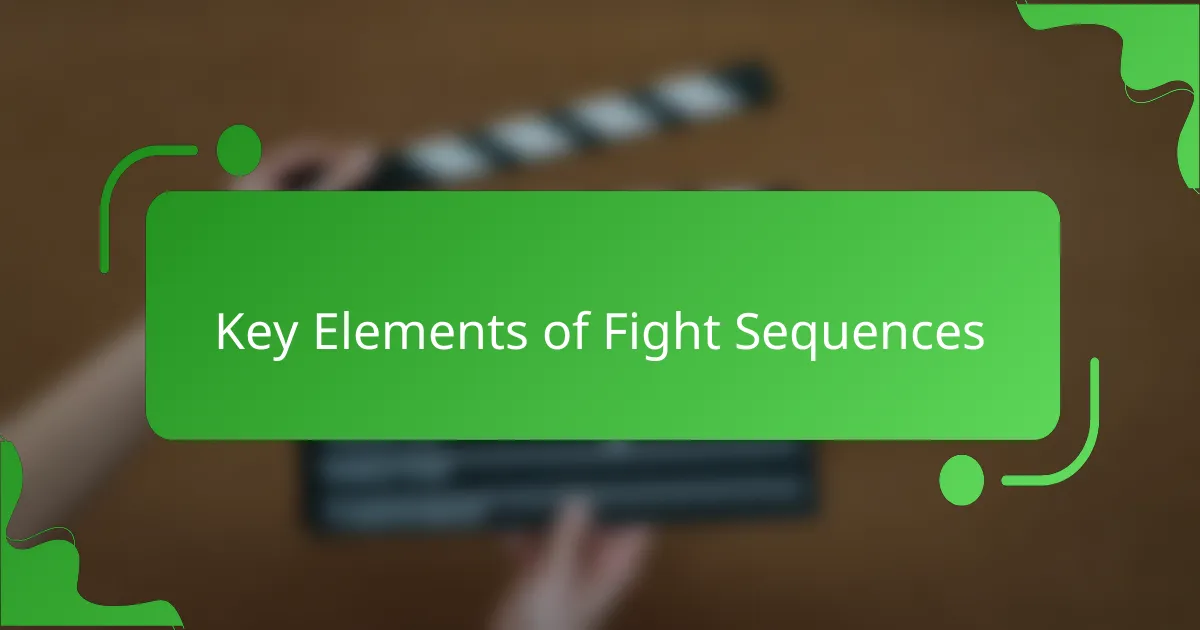
Key Elements of Fight Sequences
Fight sequences are the heart and soul of any action short film. When developing them, I believe it’s essential to focus on choreography, pacing, and character motivation. For instance, I vividly remember crafting a scene where every movement had to reflect not only the physical struggle between characters but also their emotional stakes. The intensity of the moment made me realize that a well-executed fight isn’t just about the action; it’s about telling a story through every punch and kick.
Through my experience, I’ve found that the following key elements are crucial when creating memorable fight sequences:
- Choreography: Every move should be planned to create a fluid and engaging visual narrative.
- Pacing: The rhythm of the fight influences the audience’s emotional response; quick cuts heighten tension, while longer shots can emphasize weight and impact.
- Character Motivation: Understanding why characters are fighting makes the sequence more compelling and relatable.
- Use of Space: The environment shapes the fight choreography; make use of obstacles or unique setups.
- Emotional Stakes: Infusing personal stakes into the fight builds a connection with the audience, making them care about the outcome.
By focusing on these elements, I’ve been able to create fight sequences that resonate emotionally and visually with viewers.
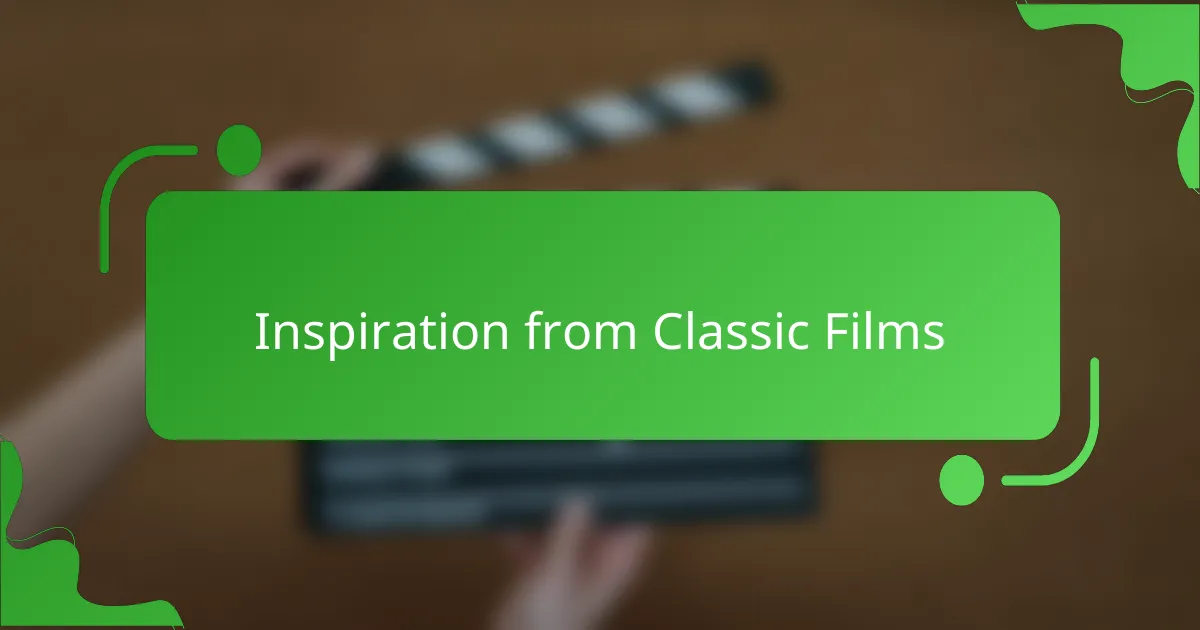
Inspiration from Classic Films
When I first watched classic films like “Kill Bill,” I was captivated by the intricate fight sequences. The choreography was not just about the action; it told a story, showcasing the characters’ emotions and motivations. This inspired me to think deeply about how every punch and kick could convey tension, making the viewer not only see the fight but feel it as well.
Drawing inspiration from these films, I’ve developed a few key techniques that have shaped my approach to fight choreography:
- Emotion-Driven Movement: Every movement should reflect the character’s emotional state in that moment.
- Cinematic Influences: Incorporating elements from iconic fight scenes, like those choreographed by Yuen Woo-Ping and Quentin Tarantino.
- Character Focus: Ensuring that each fight tells a specific story tied to the character’s journey.
- Practicality: Keeping sequences grounded in reality helps heighten their impact, much like in classic martial arts films.
- Dynamic Camera Work: Utilizing camera angles and movements that enhance the sequence without overshadowing the action itself.
These principles have guided me and made my work more relatable and engaging for viewers, just like the films that have inspired me.
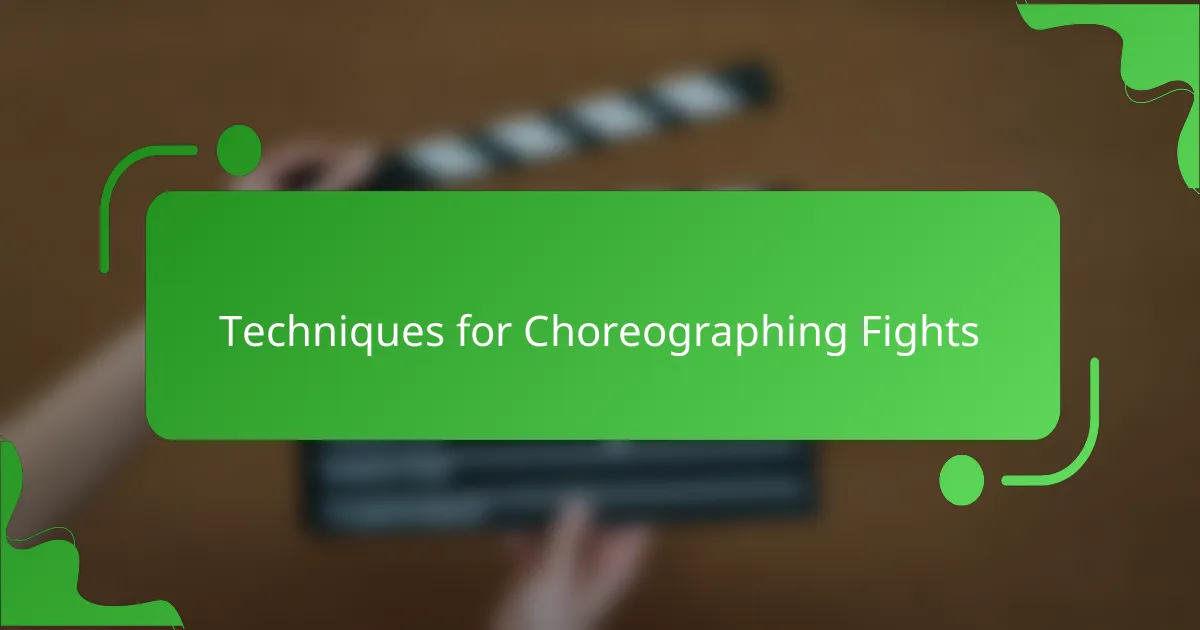
Techniques for Choreographing Fights
When I began choreographing fight sequences, I quickly learned that understanding rhythm is crucial. Just like in any dance, timing can make or break the fluidity of a scene. I remember feeling a rush of excitement the first time I synchronized movements with the soundtrack—everything just clicked, and it created a captivating energy on screen.
Additionally, incorporating varied techniques keeps the audience engaged. For example, mixing slow-motion shots with fast-paced action sequences creates a dynamic visual contrast. I often experiment with different styles, like martial arts and street fighting, to find the right balance that feels authentic to the characters I’m portraying.
It’s also important to emphasize safety and cooperation among actors. I’ve found that fostering an environment of trust leads to more impressive performances. My best sequences emerged when every participant felt confident to explore their movements without fear of injury.
| Technique | Description |
|---|---|
| Rhythm | Synchronizing movements with music to enhance emotional engagement. |
| Diversity | Combining various fighting styles to maintain viewer interest. |
| Safety | Creating a trustworthy environment promotes better performances and reduces the risk of injury. |
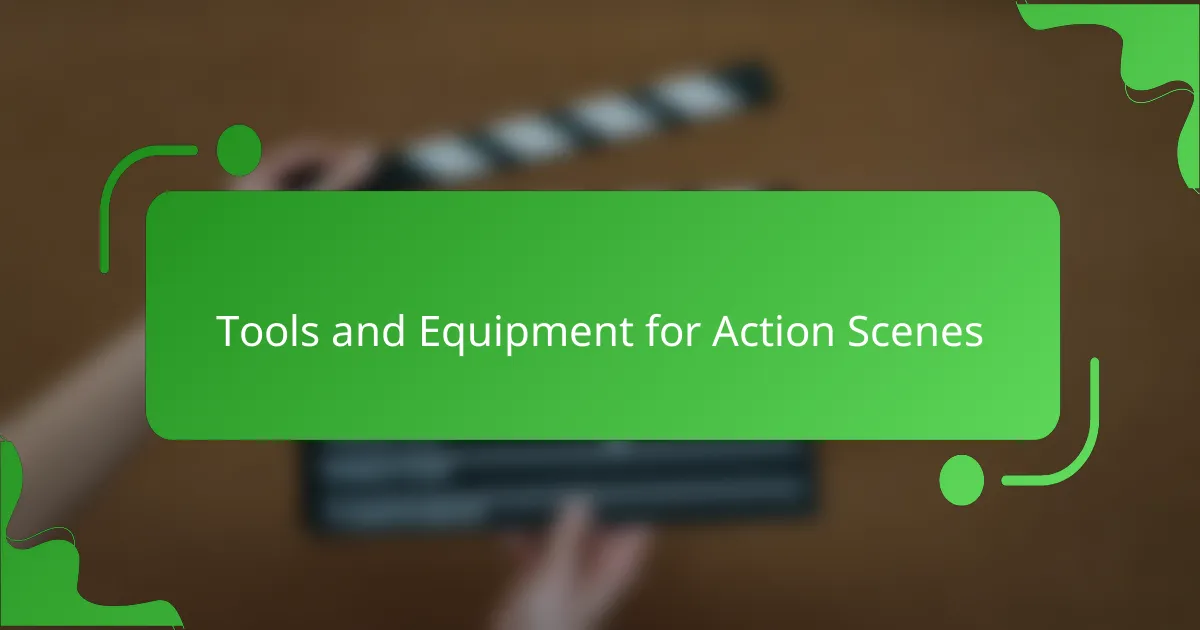
Tools and Equipment for Action Scenes
When I first ventured into creating fight sequences reminiscent of “Kill Bill,” I quickly realized the importance of having the right tools and equipment. High-quality props, like foam swords and practice weapons, not only enhance safety but also allow for more elaborate choreography without the fear of injury. I remember the thrill of executing a meticulously planned sequence, knowing that my equipment was reliable and well-suited for the intensity of the scene.
The right camera equipment is equally vital. Good lighting and versatile camera angles can transform a fight scene into a visually captivating moment that resonates with the audience. I learned early on that sometimes shooting a scene from a low angle adds an epic quality that heightens the action, drawing viewers into the excitement.
- Foam weapons (for safety during practice)
- High-quality cameras (for clear visuals)
- Tripods/stabilizers (to create smooth movements)
- Good lighting (to enhance the scene’s atmosphere)
- Costumes (that allow for fluid movement)
- Editing software (for seamless cuts and transitions)
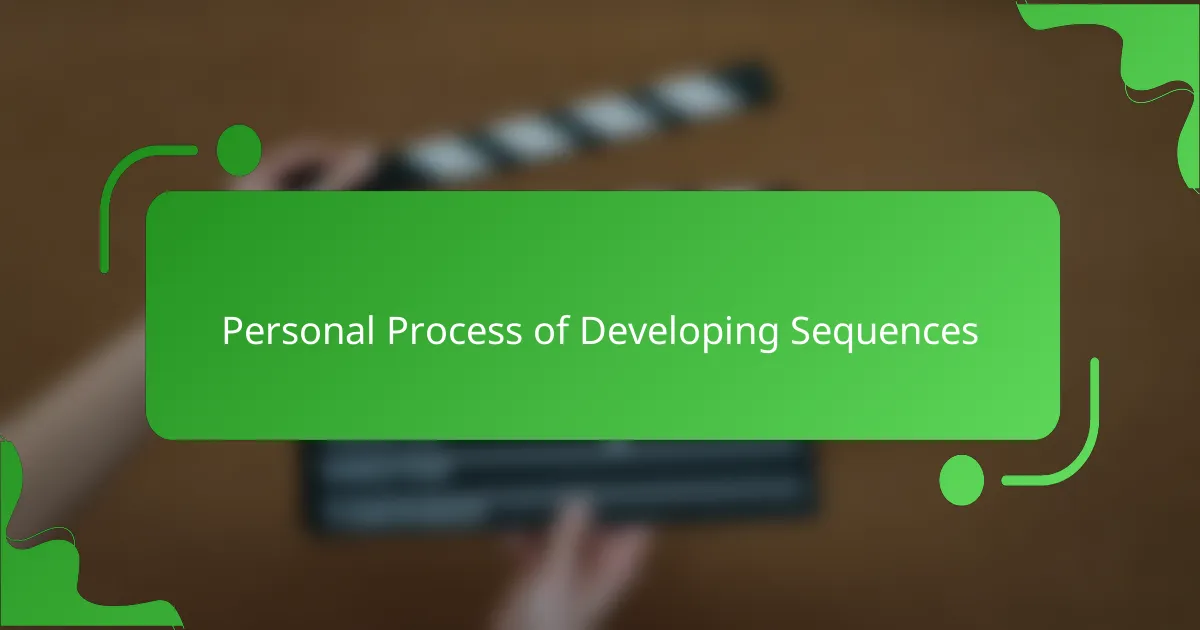
Personal Process of Developing Sequences
Developing fight sequences is a process I’ve come to cherish and refine over time. I find that the initial step involves brainstorming ideas that resonate with the characters’ backgrounds and motivations. For instance, when I crafted a sequence for a relentless protagonist, I imagined how their backstory fueled their aggression. I visualized fights as a manifestation of their inner turmoil, which makes every punch have purpose. Doesn’t it resonate more when you can see the struggle behind the action?
In my experience, breaking down a sequence into key moments helps me sculpt the action effectively. I usually start with a rough sketch, mapping out each significant movement, and then layer details like speed and emotion. There was a time when I underestimated the power of pacing, but I learned quickly that a well-placed pause can amplify tension. It was during a critical showdown that I chose to let the camera linger on the characters’ expressions, heightening both the anticipation and the stakes.
Collaboration with my team is also crucial to the development process. Sharing ideas can spark creativity, transforming a simple concept into something extraordinary. I remember one instance where an actor suggested incorporating an unexpected twist that shifted the fight’s dynamic entirely. The moment added depth and intensity, showcasing how collaboration can elevate a scene beyond what any single vision might achieve. How often do we limit ourselves by not tapping into the creative potential of those around us?
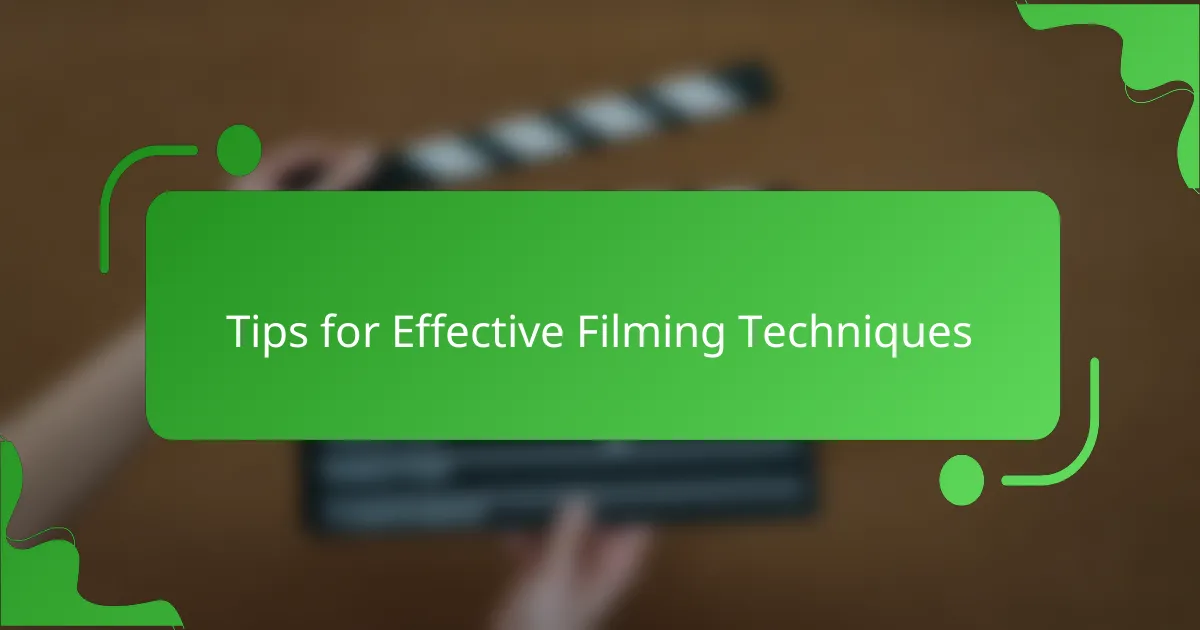
Tips for Effective Filming Techniques
When it comes to filming effective action sequences, I’ve found that planning is everything. Every moment should be choreographed like a dance, ensuring that each movement flows seamlessly into the next. I still remember the first time I mapped out a fight scene—I was both excited and terrified, but the thrill of seeing it come to life was worth the effort.
Using multiple camera angles can also elevate your fight sequences. I often shoot a scene from various perspectives—the wide shot captures the full action, while close-ups can highlight the intensity and emotions of the characters. It’s amazing how these angles can shift the viewer’s experience, drawing them deeper into the story.
Lastly, never underestimate the importance of sound. The right sound effects can amplify the impact of a punch or a kick, making each move powerful. I learned that adding sound during post-production can transform an ordinary scene into something extraordinary.
| Filming Technique | Description |
|---|---|
| Choreography | Plan the sequences thoroughly to ensure fluidity |
| Multiple Angles | Use various camera angles for depth and intensity |
| Sound Design | Incorporate impactful sound effects during editing |

